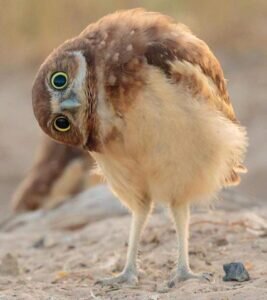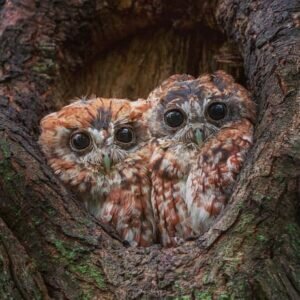Owls are solitary animals. In reality, anyone would be fortunate to see an owl in the wild; rather, you’re more accustomed to hearing their characteristic hooting sound!
A baby owl sighting would be far more unlikely, so we’ve put together this post with everything you need to know about baby owls, as well as plenty of baby owl photographs.
What is the proper name for a baby owl?
An owlet is a young baby owl that hasn’t quite gained its complete adult feathers and is still relying on its parents for nourishment, care, as well as safety. Owlets don’t really leave the nest for long because they are unable to care for themselves completely, but as they grow bigger, they will investigate the area around the nesting spot and may even be discovered on the ground.
ROOSTING – HANGING OUT
After a day or night of scavenging, owls fly to a relaxing location known as a roost. During the mating season, many owls sleep on its own or around a nest. Nevertheless, just several species sleep collectively, or share a resting space with other members of the same species.
Even though the benefits of sharing the same sleep are unknown, owls may benefit in one or more ways. Owls can keep an eye out for intruders and constantly attacking songbirds. They may indeed form a cluster to keep one another warm. During the breeding season, shared roosts make it easier for owls to choose spouses. Owls may even pass on information about good hunting locations. The roost is frequently positioned near ideal hunting areas, allowing owls to scavenge for prey as soon as they leave or return to the roost.
They hatch on separate days than their brothers and sisters
Since owls lay their eggs across some days, there will still be a size disparity between owl siblings because they hatch at various times.
This also indicates that the tiniest newborns may not survive years of food scarcity because the larger babies will gain the nutrition. This is an evolutionary strategy that is actually beneficial to the species since it ensures that at least some of the chicks survive even in difficult years.
Some baby owls are adorable, while others are terrifying, but they are all endearing. They frequently appear to be identical to adult owls, albeit more clumsy and uncertain. They exhibit a wide spectrum of expressions, from playful and innocent to grumpy.
The number of eggs laid by owls is determined on food availability
Based on the quantity of food available, owls can lay around 1 and 14 eggs.
Whenever prey populations are abundant, owls lay additional eggs than when prey is limited.
Female owls nurture eggs, but males just don’t. The female owl will shed the feathers on her abdomen when sitting on her eggs, which serves to protect the eggs warm against her skin.
If a large number of eggs are laid, it may take up to two weeks for the first and last eggs to hatch.
They Are Born With Teeth
Owl chicks are delivered with the assistance of an egg tooth, which falls off after about a week or two. This is a normal feature of all bird deliveries.
Feathers of an Owl
Every summer, owls moult, which means they shed their feathers. Their flight feathers are the largest, most colourful, and most easily identified feathers, and they moult them one at a time when flying, preening, and stretching. There may be a few feathers scattered about an owl nest or roost, but the interior will have many more. If you come across a feather, look for specific colours and patterns to determine what type of owl it may have belonged to.
MATING SEASON – PAIRING UP
Many owls breed in the late winter. Males start looking for partners by calling in the afternoon and evening air.
In general, huge owls hoot while little owls toot. The huge Barred Owl hoots a low, booming call that sounds like a question “Who does your cooking? Who prepares for all of you?” The little Northern Saw-whet Owl sings with a quick, high tone that some compare to a file scraping across the teeth of a saw.
Habits of Nesting
These species’ nesting practises differ greatly. Some nest in enormous tree nests made by other birds, while others nest amid rocks. Others are cavity nesters who live in holes in trees made available by other sorts of birds.
This species’ birds all lay white color eggs. These are laid over a few days, and incubation begins with the laying of the first egg.
Birdhouses for Owls
Man-made bird houses can attract a variety of owl species. To mention a few, there are Screech Owls, Barn Owls, and Great Horned Owls.
There is no list of nesting materials because they do not create nests but rather reuse the cavities and nests of other birds.
Visual of an owl in a dream
The appearance of an owl in a dream represents virtue, magic, wisdom, enlarged awareness, as well as insight. You have a strong connection with your intuitive senses plus psychic power. Death, darkness, and the unconscious are also associated with the owl. An owl’s appearance may be a message to let go of the past or certain undesirable tendencies.
Interesting owl facts!
The eggs of owls are white.
Owls have three pairs of eyelids.
Owls have the ability to turn their heads upside down.
Owls may live anywhere except Antarctica.
Owls can easily open and close their ears.
Baby owls will be fed food brought by their parents, which will be ripped up and ripped up again. Baby owls consume animals, birds, and reptiles.
Baby owls do definitely sleep on their stomachs. Because an owlet’s (baby owl’s) head cannot hold the weight of its large head, they must sleep flat on their bellies with their heads off to the side in order to breathe. Their large head is all about detecting sound and vision from a young age, making them wonderfully cute but also necessitating a reasonable sleeping position.
What you should do if you find a baby Owl
When you encounter a young owl, it is critical to identify the species. The best line of action depends largely on the species of owl you’re dealing with. If you are to assist a wounded Owl, the first aim must be to reduce stress. Birds are frequently killed by shock rather than injury. Any delay raises tension, thus quick action on your side is required. If the Bird enables you to approach it and pick it up, it is likely to be in a critical condition and may be more traumatised by being handled. Do not attempt to examine the injured bird on your own. This adds to its stress and should be handled by a trained rehabilitator or veterinarian.
The steps below will walk you through what to do if you come across an injured owl or bird of prey:
- To keep the injured bird warm, gently drape a sweatshirt or blanket over it.
- Place the bird in a well-ventilated, darkish cardboard box that is not too small that it sustains additional injuries, but not too spacious that it can jump around inside. If possible, line the bottom of the box with a towel or, if that is not possible, with newspaper. Never use straw or sawdust in the box, and never put water in it.
- Try not to feed the bird. As quickly as possible, transport the bird to a nearby bird of prey centre or raptor rescue organisation.
Another important thing to remember is to make a record of where you found the bird so that it can be released to the wild in its natural habitat.
I hope this article gave you sufficient information about baby owls.
Read Also
Owl Legs- All You Need To Know With Pictures
Baby Flamingos- All You Need To Know with Pictures






1 thought on “Baby Owls – All You Need to Know with Pictures”